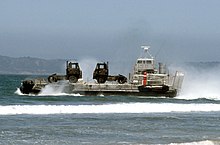LACV-30
| Lighter Air Cushioned Vehicle, 30 Tons | |
|---|---|
 A US Army LACV-30 | |
| Type | Hovercraft |
| Place of origin | United States |
| Service history | |
| Used by | U.S. Army |
| Production history | |
| Manufacturer | Bell Aerospace Textron |
| Unit cost | $5.833 million (1983)[1] |
| Produced | 1983-1994 |
| No. built | 26[2] |
| Specifications | |
| Mass | 29,510 kilograms (65,060 lb) |
| Length | 24 metres (79 ft) |
| Width | 12 metres (39 ft) |
| Crew | 5 |
| Engine | 2 Pratt & Whitney PT6T Twin-Pac gas turbines 1800 hp (ea.) |
| Payload capacity | 30 tons (27 tonnes) |
| Maximum speed | 97 kilometres per hour (60 mph) |
The LACV-30 (Lighter Air Cushion Vehicle, 30 tons) was a hovercraft used by the U.S. Army Mobility Equipment Research and Development Command (MERADCOM) for offloading cargo from amphibious ships. For logistic transport, the Army was already using the LARC-V and LARC-LX, huge 4-wheeled vehicles referred to as 'barges on wheels'. The Army used the LACV-30 to transport 20 ft. standard MILVAN containers as well as outsize loads that would not fit on a LARC-V or LARC-LX. MERADCOM operated 24 LACV-30s between 1983 and 1994.[3]
The LACV-30 was derived from the civilian Bell Voyageur air-cushion vehicle (hovercraft). It is capable of carrying 30 tons (27 tonnes).[2] The hull is that of a large barge, but behind the deck house at the stern, there are 2 air propellers, which are followed by rudders, while under the hull there is a cushion of air which is inflated by 2 fans. There is a large crane at the bow, with a rectangular superstructure shaped like that of a typical river barge.[2]
A noteworthy feature of the vehicle is that, if necessary, it can be divided into 15 sections that can be transported and reassembled, and put in the water by its crew.[citation needed] The LACV-30 was capable of traveling in conditions of up to sea state 3.[3]: 7
The LACV-30 was criticized for its high purchase and operating costs: it consumed five to seven times as much fuel as a conventional lighter. An Army report further criticized its poor reliability, availability, and maintainability.[2] The LACV-30 was also often unable to carry the advertised 30 tons, with typical loads being 22 to 23 tons,[2] although modifications begun in 1983, namely adding a new stern seal and raising the longitudinal seal, enabled the LACV-30 to carry 30-35 tons.[3]
The LACV-30s were operated by 8th and 331st Transportation Companies in the U.S. Army's 11th Transportation Battalion from 1983 to 1994. Each company had 12 vehicles.[4] The U.S. Navy conducted tests on the LACV-30 from 1985–1988.[5]
Following their Army service, most LACV-30s were sold to a Native Alaskan company for use as cargo and passenger transports in Alaska. In 1996, the U.S. Postal Service investigated the possibility using LACV-30 hovercraft to deliver mail to remote villages in the vicinity of Bethel, Alaska. The LACV-30 was rejected for environmental concerns, particularly its high noise level. The LACV-30 is comparable in noise level to modern military jets or first-generation commercial jet airliners.[2]
References
[edit]- ^ Armor, January–February 1983, v. 92, no. 1, p. 51.
- ^ a b c d e f Pike, John. "Lighter Air Cushioned Vehicle 30-ton (LACV 30)". GlobalSecurity.org. Retrieved 18 July 2018.
- ^ a b c LACV-30 INCREASED PAYLOAD STUDY (PDF) (Technical report). Bell Aerospace Textron. August 1983. 7467-928028. Archived (PDF) from the original on 2 March 2017 – via DTIC.
- ^ Killblane, Richard; Nalli, Diana. "8 th Transportation Company" (PDF). www.transportation.army.mil. U.S. Army Transportation Corps. Retrieved 19 May 2016.
- ^ Carisle, Rodney P (1998). Where the fleet begins: A History of the David Taylor Research Center, 1898-1998. Washington DC: Naval Historical Center Department of Navy. p. 502. ISBN 0160873088.
